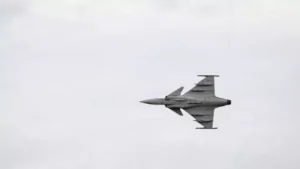

It’s been weeks since Israel concluded its 12-day war against Iran, and still many questions remain in regards to how the Israel Defense Forces (IDF) were able to achieve what they did. One puzzle that stands out above all the others has to do with the Israeli Air Force (IAF) being able to sustain operations and achieve significant effects over such great distances. The borders of Israel and Iran are separated by nearly 600 miles at their closest points.
With just seven nearly antique KC-707 tankers in its inventory, getting F-15s, F-35s, and F-16s from Israel to Iran and back many times over nearly two weeks became a major curiosity. The U.S. military had the unique ability to provide Israel with the tanking capacity it needed, but there has been no acknowledgement or proof that this occurred, regardless of claims by some. Still, speculation continues that the U.S. did support Israel with aerial refueling in secret. Now the Department of Defense is flat-out denying that it provided any such support for the IAF during the conflict..
As the recent war went on, Israeli fighters pushed further east over Iranian airspace, allowing the jets to bring more powerful, deeper-penetrating, and in some cases more numerous, direct attack weapons to bear on Iranian targets. But with just seven aging KC-707 tankers in its force, getting F-15s, F-35s, and F-16s from Israel to Tehran was clearly a monumental undertaking.
In the opening shots of the war, where Israel attacked targets near the Iran-Iraq border and launched many standoff weapons deeper into Iran from afar, it was clear the IAF massed everything it could. The first waves of fighters would be maximized to take advantage of the opening ‘shock’ of the conflict in an attempt to degrade Iran’s air defenses and command and control architecture. Initial strikes on key long-range missile and nuclear sites were also part of this opening series of barrages. The IAF was helped greatly by Mossad’s destruction of enemy air defenses (DEAD) campaign from within Iran itself, which you can read more about here. Nevertheless, everything must have been done to allow as many fighter aircraft to participate as possible.
Fitting as much external fuel on the fighters – the IAF’s F-15 fleets and F-16Is are all notably fitted with conformal fuel tanks and have the ability to carry drop tanks – was clearly necessary. Even dropping external tanks once they are empty to maximize range appears to have been part of the plan during the initial high-volume strikes. While drop tanks are expendable, they are not cheap and are usually retained unless performance has to be regained due to enemy threats or an in-flight emergency occurs. Dropping them to maximize an aircraft’s range is also an established tactic, but not a very sustainable one over the long term. It’s also one that is not needed if tanker support is readily available, nor is equipping the jets with maximum external fuel in the first place, in many circumstances.
Flying very carefully planned flight profiles to squeeze every bit of efficiency out of the range of IAF tactical jets was also clearly a tactic employed, although it leaves very little margin for error or combat contingencies. In addition, we know that Israel’s F-35Is have been tweaked to provide extra range. We don’t know exactly what this entails, and it could be a cocktail of measures, from software tweaks to internal or external fuel tanks. Regardless, it was reported that many IAF fighters landed on fumes after their initial sorties.
Regardless, maximizing Israel’s fighter force of close to 300 aircraft (total inventory, not what is actually available at any given time) in the opening waves of the war with just seven tankers may have been a feat that can be explained by careful planning, drop tanks, and the use of long-range standoff weaponry, at least early on. As the war continued, the magnitude of the sorties may have dropped, but the geographical depth and power of their strikes increased. These operations were sustained for nearly two weeks.
IAF F-16Is heading out later in the conflict fully loaded with three external tanks, as well as their conformal fuel tanks, a load of SDBs, and AIM-120 AMRAAMs. (IAF)
During the conflict, TWZ discussed how, at a certain point, Israel would have to drastically reduce its cadence of operations or wrap up the war. If the U.S. had not struck Fordow with B-2s, it’s possible the war would not have ended until the IDF was able to deal with that very hardened target, which would have likely required a ground operation very deep into a highly-defended area of Iran. Strikes would have eventually slowed as the IAF’s sortie rates degraded, and especially those of its overworked and geriatric tankers.
The fact that, according to the USAF, Israel did this without the help of clandestine USAF tanking is remarkable. The only other possibilities in terms of direct support would be using airfields in an Arab country, such as Jordan or Saudi Arabia. Saudi Arabia also has tankers that could refuel IAF jets. Yet there is absolutely no evidence that this occurred in any way. Using Azerbaijan for forward basing is another possibility some have raised, but there is no hard evidence to support that, and it is very unlikely on its face.
So, as it sits, based on a fresh direct statement from the USAF, the IAF went it alone against Iran when it comes to aerial refueling, which prompts even more questions about an operation that remains partially cloaked in secrecy weeks after it wrapped up.




